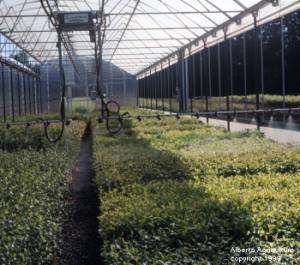| | Propagation of plant material that will be grown on to saleable size in containers or in the field is an important part of many nursery operations. Depending on the operation, a grower may choose to purchase all of the necessary lining out stock. However, with planning, in-house propagation can insure the availability of desired species. Plant availability, ease of propagation, facilities and available time are some factors to consider regarding propagation.

Meadow Lake
For the nursery, propagation can be divided into two methods: sexual propagation using seed, and asexual (vegetative) propagation by cuttings, grafting or tissue culture. Refer to the texts listed in Appendix A, "Propagation" for specific propagation information for individual species and cultivars.
Sexual Propagation
Sexual propagation using seed requires a minimal amount of materials and a basic knowledge of seed biology. Species propagated by seed typically produce seedlings sharing characteristics from their parents.
The seed of many species contain chemical and physical inhibitors that induce dormancy and must be overcome for germination. Seed stratification and/or scarification are used to overcome dormancy. To stratify seed it is placed in moistened medium and chilled for a period of time specific to the seed. A few species require a warm stratification period followed by cold stratification. Seed is scarified by breaking, scratching, mechanically or chemically altering or softening the seed coat to make the seed permeable to water.
Fall seeding into outdoor seed beds will overcome seed dormancy for many species as winter will stratify the seeds naturally. A grower using plastic bags, moistened peatmoss or sand and a refrigerator, can stratify the seed of most species for seeding at his/her convenience.
Asexual Propagation
Many woody plant selections and cultivars are propagated asexually (vegetatively) with cuttings, budding, grafting, or tissue culture to produce genetically identical plants (clones) which maintain the desired qualities of the parent plant. Vegetative propagation is also used to propagate plants when seed is unavailable or difficult to germinate.
Nurseries primarily propagate woody plants using stem and root cuttings, budding and grafting and to a limited degree, utilize tissue culture plantlets. Tissue culture or micropropagation is done under laboratory conditions and is used for high value, difficult to root species.
Stem cuttings can be separated into three basic types:
- Hardwood Cuttings are taken in the dormant period (fall and winter) from the previous season's growth (hardwood). Stem pieces generally less than 1.5 cm in diameter are cut into 15 - 25 cm pieces depending on the species and put into cold storage. They are typically planted into the field in the spring for rooting. This method requires minimal equipment. Poplar and willow are often propagated using hardwood cuttings.
- Softwood Cuttings are taken from new spring stem growth in both deciduous and evergreen species when the stem is still soft not woody. Softwood cuttings are used to propagate many species, particularly shrubs. These cuttings are several nodes long and include leaves. To avoid excessive moisture loss from leaves due to transpiration cuttings are planted in media and maintained under moist air conditions. A propagation structure to maintain moist conditions may be simply a bench with a plastic tent, with misting nozzles and automatic timers or with a fogging unit. It can be in a greenhouse, plastic hoop-houses or even cold frames. Softwood cuttings can root quickly and are very effective for many species.
- Semi-hardwood Cuttings are taken later in the growing season when the current season's growth has become woody (usually from July to September). Species such as juniper, cedar and Euonymus can root from these cuttings. A misting system or a cold frame with shade and humidity can be used. Semi-hardwood cuttings are not as common as hardwoods or softwoods in Alberta.
Root Cuttings are made from roots dug in the late fall or early spring. The root pieces can be just under 1 cm up to about 2 cm in diameter. Root pieces can be stored in moist peat or cut into pieces at least 5 centimeters in length and planted into pots or beds for growing. These cuttings do not require high moisture conditions for growth. Root cuttings can be difficult to collect and can be detrimental to the mother plant because of the removal of part of the root system. Some poplars are propagated with root cuttings.
Grafting and budding are techniques involving the union of two plants. The 'scion' which may be a single bud or several buds on a stem is the top part of the plant which is grafted onto a rootstock (understock). In budding a single bud is attacted to the frootstock. In grafting a larger stem piece with serveral buds is attached to the rootstock.
Grafting and budding are used when the desired plant has a poorly developed or tender root system, or if other desirable qualities are passed from the rootstock to the scion (ie. dwarfing, disease resistance, etc). Grafting and budding require grafting knives, waxes, rubber bands and experience for success.
Apples, roses and lilacs are often grafted or budded.
N.G. Seymour, Nursery Crops Technologist, Crop Diversification Centre South |
|